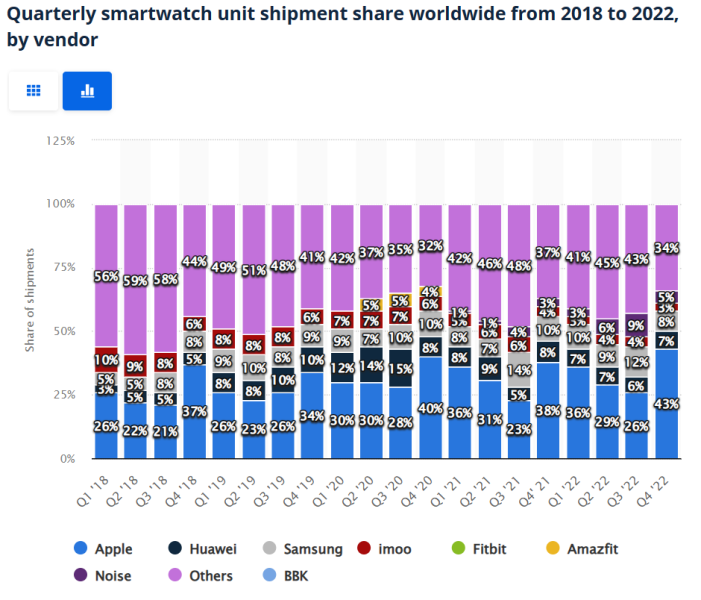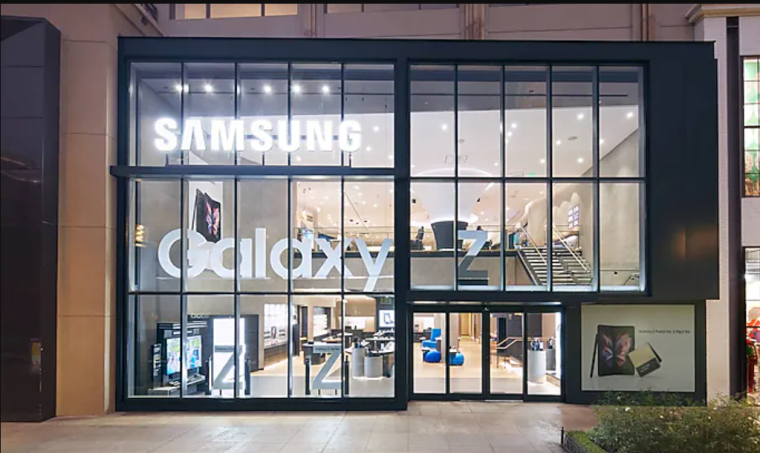In this article, Business2Comunity’s statistics experts dive into Samsung statistics to unearth the story of how a grocery trading store became one of the leading technology companies worldwide.
Samsung smartphones, tablets, and wearables are frequently in competition with other premium brands like Apple. From appliances to memory chips to semiconductors and even medical equipment, Samsung offers a wide range of products to its many customers around the world.
In this article, we will guide you through the interesting history of the company, covering both its innovations and controversies. Whether you’re an experienced investor considering adding Samsung to your portfolio or just researching tech giants, you’ll find everything you need right here, with over 70 recent Samsung statistics available for you.
Samsung Statistics Highlights
- Memory chip market saturation and reduced demand led to a 95% profit reduction for Samsung in Q2 2023.
- In 2022, Samsung held the most patents out of any company in the world.
- Samsung’s 2016 Galaxy S7 was the first smartphone to feature a dual pixel camera.
- Samsung recalled the Galaxy Note 7 smartphones, a move that cost the business $5.3 billion.
- Samsung’s global smartphone market share exploded from 3% in 2009 to 32.2% in 2012.
Key Takeaways: Samsung as a Global Leader
- Technological Advancements: Samsung’s continuous innovation in electronics has positioned it as a global leader in technology.
- Market Dynamics: The company’s significant role in shaping various tech markets, from smartphones to wearables and semiconductors.
- Corporate Growth: An exploration of Samsung’s growth trajectory from a small trading company to a tech giant.
- Strategic Challenges: Insights into the challenges Samsung faced, including high-profile recalls and market competition.
- Investment Insights: Analysis of Samsung’s financial performance and its impact on investors and the global economy.
Samsung Investment Data
Initially founded in 1938, Samsung went public in 1975 when it was first listed on the Korea Exchange.
Samsung trades on the London Stock Exchange (ticker: SMSN), the Korea Exchange (ticker: KS005930), and the Luxembourg Stock Exchange.
As of August 2023, Samsung’s market capitalization was 445.87 trillion Korean Won (KRW) or $336.8 billion.
The company is a massive player in the South Korean economy, being responsible for roughly 20% of South Korea’s GDP.
In 2012, Samsung’s shares dropped by 8% after Apple’s initial patent lawsuit victory where California courts ruled Samsung had copied iPhone and iPad features and was ordered to pay over $1 billion in damages.
In September 2016, Samsung’s stock experienced a one-day 7% price decline in years due to the Galaxy Note 7 recall as a result of faulty batteries which caused the phones to overheat and catch fire in some instances.

As of the end of 2022, Samsung’s brand value was $87.7 billion, placing it in the top five most valuable brands in the world for the third consecutive year, an increase on the previous year of 17%.
Despite a reported fall in profits in the first quarter of 2023, investors remained confident and Samsung’s stock jumped 4.5% in a single day in April 2023.
As of the second quarter of 2023, foreign investors owned 52% of Samsung, making them the majority of shareholders.
Samsung Sales Data
Samsung’s growth between 2012 and 2013 jumped by a whopping $25 billion and saw the company’s revenue cross the $200 billion threshold. The 2013 Annual Report said the jump in revenue was “driven by strong smartphone sales momentum” which outperformed the market growth, as well as more than double the tablet sales as compared to the previous year.
The pandemic had surprisingly little impact on Samsung’s overall revenue statistics. The company saw a $6 billion dip in sales income in 2020 as compared to 2019. However, by 2021, the company’s global revenue grew from $200 billion to $206 billion.
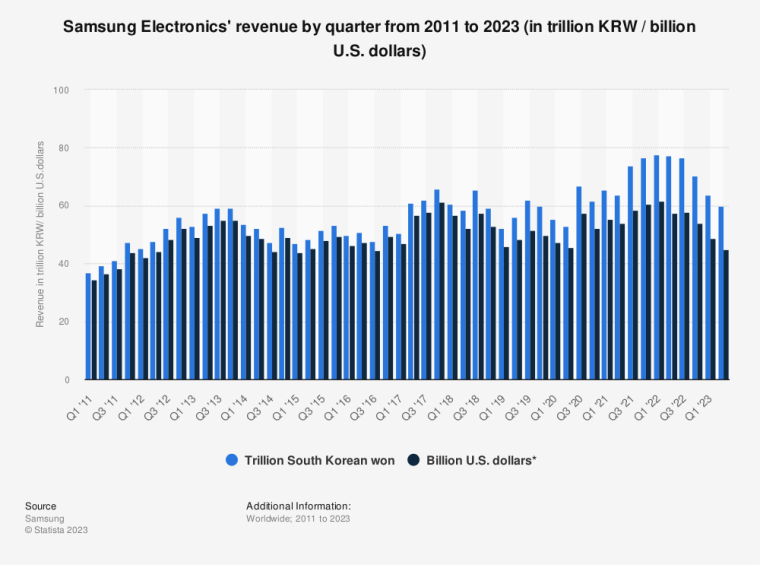
Samsung’s quarterly revenue peaked in Q1 2022 at just over $61.6 billion before it crashed over 25% to $45 billion in Q2 2023. This drop is in line with some of Samsung’s competitors, including Apple which saw an even greater drop in revenue over the same time period, as smartphone and other electronics sales fell significantly.
Samsung is the world’s largest memory chip maker. These chips are typically a cash cow for the conglomerate but they recently fell into a painful slump. In its earnings report for the second quarter of 2023, Samsung said that it expected global demand to “gradually” recover in the second half of the year but stressed macroeconomic risks could make this challenging.
Samsung Smartphone Sales Statistics
Samsung smartphones’ market share exploded between 2009 when it stood at just 3% and 2012 when it reached 32.2%. Samsung has been a key player in the smartphone space ever since and has consistently remained among the top five smartphone manufacturers.
Over the past few years, Samsung has traded the title of the world’s largest smartphone manufacturer back and forth with Apple about every few quarters. Both companies have run into setbacks that put them behind the other, such as Samsung’s disastrous Galaxy Note 7 battery fire and subsequent widespread recall.
The incident caused Samsung’s global market share in premium phones to crash from 35% to 17%. Since then it has been able to recover by building some of the highest quality phones on the market and avoiding similar scandals.
Samsung’s smartphone production was over 260 million smartphone units globally in 2022, constituting a 21% market share. This represented a dip from the previous year, when the company shipped 272 million Samsung phones, and 2019 when it shipped over 295 million devices.
Samsung smartphone shipments hit 60.5 million in the first quarter of 2023, and a further 53.5 million smartphone shipments in the second quarter of 2023.
Samsung Tablet Sales Statistics
Samsung has been at the forefront of tablet sales for over a decade, selling millions of devices every quarter. Its tablet business peaked in Q4 2013 when Samsung sold over 13.5 million units in a single quarter.
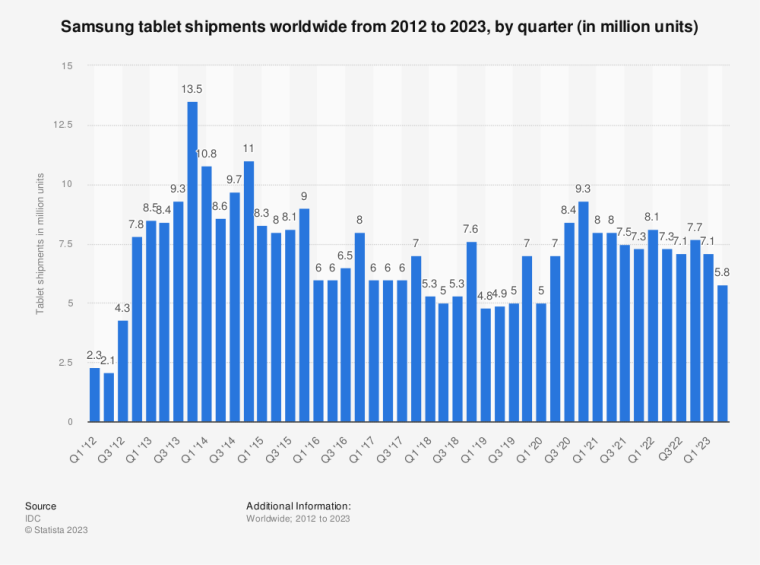
After a lengthy slump between 2015 and 2020, Samsung’s tablet sales started to skyrocket again before dropping to only 5.8 million units in Q2 2023. This is in contrast to the first quarter of the year when the company shipped 7.1 million units.
Despite Q2’s poor performance relative to previous quarters, Samsung remained the second-largest tablet vendor globally by market share. Samsung’s share of the tablet market fell to 20.6% in the second quarter of 2023, down from 23.1% in the previous quarter.
Samsung Wearables Sales Statistics
Samsung usually comes in second or third based on the market share of wearables and especially smartwatches with its Galaxy Watch series. Global brands Huawei and Apple are often its closest competitors.
In the fourth quarter of 2022, Apple held 34% of thse smartwatch unit shipment sales worldwide, while Samsung held just 8%.
Samsung’s smartwatch market share skyrocketed to 14% in the third quarter of 2021, coinciding with the launch of the popular Galaxy Watch 4. This was its best-performing quarter in the sector since 2018, as evidenced by the chart below.
Samsung Product Stats
In 2022, Samsung became the largest patent holder in the world when it was granted 6,248 patents in just one year. For those familiar with its extremely advanced lineup of devices including the Galaxy Z Fold and Galaxy Z Flip, this likely isn’t surprising. The tech giant spent more than $20 billion on research and development activities in 2022, making it the largest non-US spender on R&D.

In 2023, Samsung declared 2,795 patents in the 5G patent realm and was granted 1,728. Samsung’s competitor Nokia is a close second with 1,584 granted patents for 5G tech.
History of Samsung’s Smartphone Prowess
Samsung is the biggest manufacturer of smartphones in the world and the second most popular smartphone brand in the US as of 2023.
The Galaxy S became the first smartphone to feature a Super AMOLED display in 2009. AMOLED stands for Active Matrix Organic Light Emitting Diodes – a thinner, lighter, more flexible OLED screen.
Galaxy series smartphones were the world’s first to ship with this type of technology, paving the way for larger smartphone screens of 4 to 6 inches, compared to the previous 3″.
In the Galaxy S7, Samsung created the first dual pixel in a smartphone camera in 2016. Previously only available in DSLRs, Samsung incorporated this feature in their phones by increasing the amount of light absorbed by front and rear cameras, revolutionizing the smartphone camera market.
Samsung made headlines when it introduced its first folding phone in 2019, the Galaxy Fold. Just a year later, the Galaxy Z Fold2 and Galaxy Flip were released. This gave customers bigger screens – the Galaxy Z Fold3 for instance, came with a 7.6in screen when unfolded.
Foldable global smartphone shipments are expected to grow to 26 million units in 2023 and are particularly popular with enterprise Samsung users. In fact, the South Korean company reported that from January to October 2022, the number of foldable smartphones contracted to enterprise customers rose by 105% compared to the same period in 2021.
The Galaxy S10 marked the end of an era, as the series jumped to S20 in 2020. The goal was to “kick-off” the next decade of innovation and demonstrate the desire to pioneer an ecosystem focused on 5G, artificial intelligence, and the Internet of Things (IoT).
History of Samsung: Timeline
- 1938: Samsung is founded by Lee Byung-chul as a grocery trading company.
- 1969: Samsung Electronics is established.
- 1970: The company starts producing black and white TVs and by 1971, exporting them globally.
- 1975: The company is listed on the Korea Stock Exchange on June 11 and officially goes public.
- 1977: Samsung begins mass producing and exporting color TVs.
- 1977: The company completes its acquisition of Korea Semiconductor Co.
- 1978: The first overseas Samsung office opens in the USA.
- 1983: The company begins making personal computers for the first time.
- 1987: Lee Byung-chul dies. His son, Lee Kun-hee, takes over as chairman of the Samsung Group.
- 1998: The world’s first digital TVs are produced by the company.
Samsung into the 21st Century
- 2004: Samsung launches the world’s biggest LCD TV at the time, 46″ corner to corner.
- 2008: Samsung becomes the world’s largest television manufacturer; a title it still holds in 2023.
- 2010: Samsung releases the first AMOLED-display smartphone; a move which marks the beginning of the large-screen smartphone era.
- 2011: Apple sues Samsung for patent infringement and seeks damages amounting to more than $2 billion.
- 2012: Samsung’s smartphone market share stands at 28.8%, outpacing nearest rival Apple at 23%.
- 2016: Samsung recalls the Galaxy Note 7 mobile devices due to issues with batteries overheating and causing fires, reportedly costing the business $5.3 billion.
- 2016: Despite the smartphone recall, Samsung’s share price soars to an all-time high of $1,528 per share.
- 2017: Third-generation Samsung heir Lee Jay-yong is arrested on bribery and corruption charges.
- 2018: Samsung loses its 7-year-long court battle with Apple; Apple is awarded $539 million in the US patent case.
- 2019: The company releases the Galaxy Fold, a first-of-its-kind foldable smartphone.
- 2021: Samsung heir Lee Jae-yong is given a two-year bribery sentence; news of the sentence sees Samsung Electronics shares drop by 4%. He is released from prison the same year.
- 2022: The company launches its gaming hub; a brand new game streaming platform is now available on newer TV models. In the same year Lee Jae-yong becomes the executive chairman of Samsung Electronics board approval.
- 2023: Samsung is the leading smartphone vendor with a global market share of 22.5%; Apple and Huawei are its closest competitors.
Samsung Demographics
Samsung is a global brand, and as such, its consumer electronics products are typically widely accessible globally. The only notable exception is North Korea where Samsung products are banned. It’s believed Samsung’s products are still available on the black market.
Around a third of Samsung’s revenue comes from its home continent of Asia, making it a key market for the business.
Samsung’s smartphones in particular dominated the Asia-Pacific Region in 2022.
Samsung Smartphones Demographics
As of 2022, Samsung’s smartphones held around 63% of the market in South Korea. It dominates several other markets in the APAC region as well. The countries where Samsung phones have the biggest market share in APAC are:
- Papua New Guinea – 62.6%
- Afghanistan – 59.2%
- Mongolia – 44.6%
- Sri Lanka – 43.3%
- Bhutan – 33.6%
Samsung is also represented in larger markets in the APAC region. Its smartphone market share in these markets is as follows:
- Hong Kong – 30.4%
- Australia – 27.5%
- Singapore – 17.5%
- India – 17.1%
- Japan – 6.2%
- China – 2.3%
When it comes to revenue, the South Korean market is vital. Approximately 16% of the revenue generated in 2022 was generated by South Korea.
As of March 2023, over 30% of people aged between 30 and 49 and 35% of adults over the age of 50 are Samsung smartphone users in the US. Only 16% of Americans aged under 30 use Samsung users when it comes to smartphones.
A 2020 survey of American teenagers found that 85% owned an iPhone and 88% wanted their next smartphone to be an iPhone. As of December 2021, around 58% of people aged between 18 and 34 used iPhones in the US. The remaining 42% used Android phones.
While 95% of people aged between 18 to 29 owned a smartphone in the US as of 2021, only 61% of those aged 65 and above owned one.
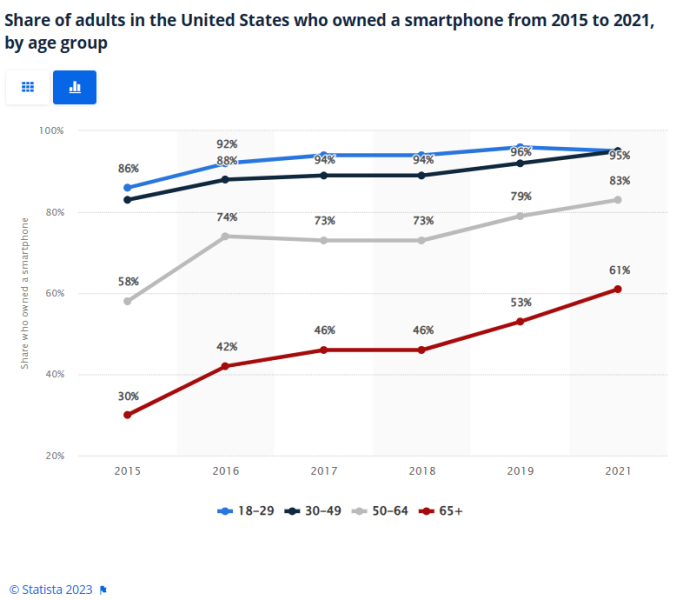
The percentage of people over the age of 65 who own a smartphone in the US more than doubled between 2015 (30%) and 2021 (61%), showing that smartphone adoption is becoming more and more widespread across all age groups.
Samsung Tablet Demographics
Tablet ownership shows different patterns when it comes to age demographics.
While 39% of people aged 18 to 29 in the US own a tablet, this number rises to 55% for those aged 30 to 49 and dips to 48% for those aged 50 to 64 as of 2023.
Apple’s iPads remain the preferred choice when it comes to market share. As of 2023, Apple owned 37% of the worldwide tablet market while Samsung came second with 20.6%.
Samsung Business Data
Samsung Electronics is headquartered in Suwon-si, South Korea.

There are 270,372 Samsung Electronics employees that work across its global network across 74 countries in more than 230 bases.
There are a total of:
- 7 design centers
- 15 regional offices
- 31 production sites
- 41 R&D centers
- 108 sales offices
In 2018, Samsung launched the world’s largest factory to make the company’s smartphones in Noida, Uttar Pradesh, India. At launch, the new Samsung factory was expected to double the mobile phone production in the area from 68 million to 120 million units per year.
For its customers, Samsung has six US-based Samsung Experience Stores.
The six Samsung Experience Stores can be found in:
- Dallas – Fort Worth, Texas
- Garden City, New York
- Houston, Texas
- Los Angeles, California
- Paolo Alto, California
- 837 Washington Street, New York City
The stores are designed to be interactive playgrounds allowing visitors to play, learn, and seek solutions. Their 837NYC store based in New York is “more than a store” and incorporates Samsung innovations as well as interactive events and art installations.
Samsung Competitor Statistics
Samsung’s main competitor is Apple across the smartphone and tablet spaces. When it comes to smartwatches, Samsung, Huawei, and Apple are typically in the top three spots for market share.
In the second quarter of 2011, Apple held 61.5% of the tablet market, while Samsung held just 7.3%. In contrast, by the second quarter of 2023, Apple held 37% of the tablet market, while Samsung held 20.6%.
Samsung shipped 5.8 million tablets in the second quarter of 2023, while Apple shipped 10.5 million. Apple shipped about 62 million iPads in 2022, whereas Samsung was only able to ship about half as many of its tablets.
The table below shows Apple vs Samsung’s tablet shipment market share over the last 5 years. These are based on numbers from Q2 of a given year.
| Apple | Samsung | |
| 2023 (Q2) | 37% | 20.6% |
| 2022 (Q2) | 31% | 18.1% |
| 2021 (Q2) | 31.9% | 19.6% |
| 2020 (Q2) | 32.1% | 18% |
| 2019 (Q2) | 37.6% | 15.1% |
It’s estimated that Samsung held less than 1% of the market share for smartphones in China in 2022, a drop from 20% in 2013. Just under 40% of Chinese people had a Huawei phone and more than 20% had an Apple phone as of 2022.
Still, in the Latin American market, specifically Brazil, well over 40% had a Samsung phone and under 20% had an iPhone as of 2022. Samsung also dominates the global smartphone market space including places like India, Germany, Russia, Mexico, and some European market spaces like Spain.
When it comes to smartwatches, Apple and Huawei are Samsung’s main competitors. Apple holds the biggest piece of the smartwatch pie by far.
In 2022, Apple’s smartwatch market share globally was 30% while Samsung’s was 10.1% and Huawei’s was 6.9%.
However, in 2020, Apple held 32.9% of the smartwatch market share globally, while Samsung held 8.9% and Huawei held 10.7%.
Huawei and Samsung are in a constant battle for second place when it comes to this particular market. Apple is steaming ahead with, on average, triple the market share of Samsung.
Wrapping Up
Samsung has maintained its position as a leading technology company through continuous innovation and a broad product range.
Despite facing challenges like market fluctuations and intense competition, Samsung’s strategic investments in R&D and global market presence continue to drive its success.
As it navigates the evolving tech landscape, Samsung’s commitment to innovation remains clear, keeping it at the forefront of the electronics industry.
FAQs
How many people use Samsung?
How many Samsung phones are there?
Is Samsung publicly traded?
References
- Nasdaq
- Samsung
- BBC
- Reuters
- Apple
- The New York Times
- The Wall Street Journal
- Guardian
- The Washington Post
- X
- The Korea Times
